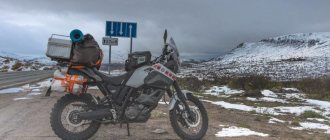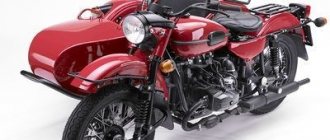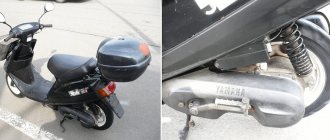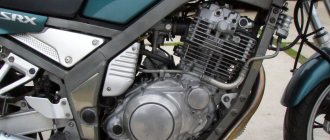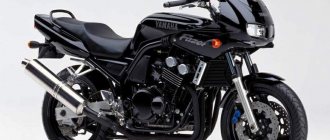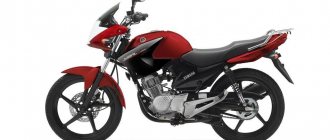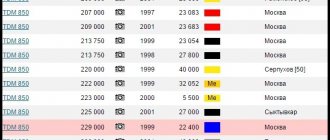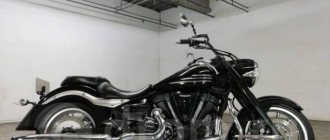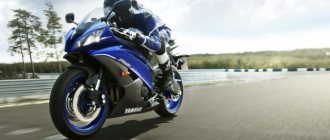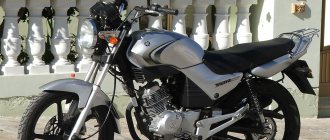Bike features
Here are the main features of the bike:
- long-travel suspensions with adjustable capabilities;
- spacious fuel tank;
- fuel injection system.
Perhaps the most important feature of this touring enduro from Yamaha is that it has a 23 liter gas tank to travel about 600 km. This is a very impressive figure, because many motorcycles can only travel 300 km. For the Yamaha XT660Z Tenere this is very important, because this bike is designed for long trips.
Design of YamahaXT660Z Tenere
By reviving the bike, the engineers wanted to show the bike as familiar to the user of the early tenere as possible, so most of the parts of the bikes are the same. But there are also differences.
Long travel front fork.
The towing eye is stock.
Steel frame and rigid chassis.
Having added ABS to the stock package, I had to recalculate the suspension . The braking force penetrated the shock absorbers of the old one. The front fork received a stroke of 160 mm for versions with ABS or 210 mm without it. Rear, respectively 145 mm or 200 mm .
Having slightly increased the fuel tank by only 3 liters, the developers redesigned the fuel system, which increased the range from one refueling to 600 km if not “annealed”.
For comparison, the distance from Moscow to Kursk is 520 km , to St. Petersburg - 700 km .
Exterior
The external body kit of the motorcycle has received a more pronounced enduro look.
Front end
Stock windshield.
The headlamp grille is available as an option.
Mixed type dashboard.
- The windshield looks unusual . It is not attached to the body kit according to the canons of the genre, but covers it starting from the lower technological opening and continues upward, having an average length for a road bike. Behind it is the head optics and instruments. Snooze signals are LED candles on the sides of the motorcycle.
- The mirrors are spaced wide apart, showing the situation well. The high seating position of the motorcycle, as well as the long mounting posts, will not create problems with the ears of passenger cars.
The mirrors are large enough to not protrude beyond the steering grips.
- When it comes to protecting the fork from dirt, the motorcycle has no competitors . In addition to the standard covers along the wheel, the rest of the part, going to the beam, is dressed in a corrugated pipe. The stock front fender was cut down in size.
- For those who are afraid that dirt will fly onto the engine, you can install from the old version. All hinges, wheel size and position remain the same. The crankcase cover received additional massive protection against impacts when driving over rocks.
The metal plate also covers the oil pipe, which runs exactly under the crankcase.
Back view.
- The design of the rear body kit has been revised for new tasks. Tourists often have side panniers attached to them, so a pair of exhaust pipes were taken out on both sides and lifted and pushed under the saddle—the cans don’t get in the way. To prevent them from moving, each one is secured with a light clamp to the frame.
Back view.
LED flashlight.
Double seat.
Trunk plate.
Additional trunk case.
Full body kit.
- The rear optics unit neatly protrudes from under the body kit. LED candles on the sides, stop and clearance diodes in the center. They also took care of the rear carpet; there is enough space, but it, like the side ones, was not included in the stock package - to save money.
All other solutions were standard and differed little from the first tenere.
Dimensions and weight
The weight without fuel of this motorcycle is 183 kg. The machine reaches 2248 mm in length, 864 mm in width, and 1477 mm in height. At the same time, its wheelbase will be 1500 mm, and the seat height will be 896 mm. The dimensions of this bike should not be considered excessively large, because it is, after all, a touring model.
Specifications
The bike's engine received several changes at once.
- The first tenere is the third generation of engines in the XT line, the new bike is the fifth .
- The fifth valve , has disappeared from the technological diagram .
- The fuel supply system has changed - the engine becomes fuel injection .
The main changes were applied at the turn between the third and fourth generations. But overall the concept has remained unchanged.
Engine – left view.
Engine – right side view.
It was a 1-cylinder, 4-stroke engine.
- working volume - 660 cm3;
- power - 48 hp;
- number of valves - 4;
- cylinders - 1;
- cooling - liquid;
- fuel supply - Mikuni 44 mm injector;
- ignition - TCI;
- start - electric starter;
- fuel tank - 23 l.
Transmission and clutch
The chassis has not received any changes:
- 5-speed gearbox;
- Multi-disc clutch;
- Main drive chain.
Brakes
ABS has become the main highlight of the new product.
Front brakes - two discs.
Rear brakes - single disc.
For this reason, the diameter of the front pair of discs became 298 mm , the rear - 245 mm . Support and type have not changed.
Chassis and brakes
The exterior of the XT660Z Tenere is quite successful. Of course, some may say that the bike could be made more elegant, but others will quite rightly argue that a touring enduro does not have to be beautiful at all. The frame of the model is tubular, made of steel. Spoke wheels look quite normal.
A progressive monoshock absorber is used as the rear suspension, and a telescopic fork with dimensions of 43 mm is used at the front. For braking, the XT660Z Tenere gets a 245mm disc at the rear along with a twin-piston caliper, and a pair of discs at the front, measuring 298mm each, assisted by twin-piston calipers.
Review of the Yamaha XT660Z Tenere motorcycle
Suspension
The suspension is adjustable, the settings are certainly not like in the KTM, but it’s better than without them at all.
The front suspension travel is 210mm, and the rear suspension is 200mm. This is quite enough for confident driving on soil and small touches. At first, the front end seemed very soft to me, but after adjusting it according to the instructions, everything worked out. By the way, I was surprised that the version with ABS has less suspension travel, the version is for Europeans, their dirt roads are better than our asphalt. Engine
Engine power is only 48 and a penny horses, but these are probably special horses, muscular, because they rush with dignity.
Compared to the Alp, the engine is sharper, a little nervous, while in the Alp it is smoother and more elastic. For travel, a capacity of 23 liters is provided for feeding horses; with a modest appetite of 4.5 liters, this is enough for 500 km (although returning from the Carpathians, with a cruiser of 110-120, the consumption was 4 liters O_o). The maximum I drove was 165, but there the soft suspension plays a cruel joke and begins to rearrange, but on a dirt highway at 80 km an hour on humps you can get off the ground beautifully. Control
Weight is comparable to the Transalp, still the same 200 kg, but the Tenerka steers better, it feels easier.
It’s more comfortable to ride in a standing position, it stays on the ground more confidently (you need to put on more off-road tires and check it for real). The steering wheel is high and wide, car mirrors pass under it. The seating position is upright and comfortable. In general, everything is fine here. By the way, on Tenerka it is much easier to jump over speed bumps; just load the suspension in front of him and you get a spectacular jump. Total
To be honest, in the first days I couldn’t understand Tenere, something confused me, something was missing, some little things, but then somehow all the advantages began to change my attitude, and after the Carpathians I fell in love, yes, it’s not at first glance, but it took 4000 km to travel (not bad, I drove it in a month), but now it seems to me that this is a worthy endurance for those who understand why it is necessary, and not for high-speed passage on city streets, this is a completely different element, the element of a long journey with bad roads .
Visibility is like a stepladder. And the first thing to note is the requirements for the pilot. His height must be at least ~180cm, otherwise there will be discomfort when landing and stopping. With even lower height, I think you will have to buy additional tuning, in particular a saddle lowered by several centimeters and/or an expensive special one. lowering set (-85mm). But why turn a stallion into a goat is a rhetorical question. You also need to take into account that Tenerka, weighing 209 kg, has a high center of gravity and it will not be possible to lift her “with one left hand” after a fall. In general, the pilot must match the lean, athletic figure of the motorcycle.
And the first thing to note is the requirements for the pilot. His height must be at least ~180cm, otherwise there will be discomfort when landing and stopping. With even lower height, I think you will have to buy additional tuning, in particular a saddle lowered by several centimeters and/or an expensive special one. lowering set (-85mm). But why turn a stallion into a goat is a rhetorical question. You also need to take into account that Tenerka, weighing 209 kg, has a high center of gravity and it will not be possible to lift her “with one left hand” after a fall. In general, the pilot must match the lean, athletic figure of the motorcycle.
The sound of a running engine can be described by the famous comparison of a bucket of nails. It’s not for nothing that the Yamaha logo depicts 3 tuning forks; the engine produces “music” in the gabba-hardcore style: ringing, rustling, knocking. Only hardcore, only Yamaha! However, the engine itself is extremely reliable and time-tested. It hides a modest 48 hp, but it pulls like an ox from the very bottom. The candle is located in an easily accessible place.
It’s not for nothing that the Yamaha logo depicts 3 tuning forks; the engine produces “music” in the gabba-hardcore style: ringing, rustling, knocking. Only hardcore, only Yamaha! However, the engine itself is extremely reliable and time-tested. It hides a modest 48 hp, but it pulls like an ox from the very bottom. The candle is located in an easily accessible place.
The downside of all single-barreled guns is vibration. They are present here too. A tasty sausage starts at speeds above ~140 km/h (~5500 rpm), and the tremor on the steering wheel is noticeable. For me personally, this is not critical, because it is not Schumacher. A solid tank volume of 23 liters is enough for 500-550 km. Noname AI-92 chews with a bang, and yet it’s better not to get carried away, but to pour only branded 95th and higher. The oil volume is almost like in a car - almost 3 liters.
The dashboard is perfectly readable in any weather. A nice addition to the classic dashboard is the fuel level indicator. But the navigator for the special. It didn’t fit well in the bracket - it was too far from the eyes and it was shining, so I later moved it to the steering wheel.
The tidy itself had to be fixed more carefully - there was a slight play. LED rear lights. There is an emergency warning button on the steering wheel. The ergonomics of the controls do not require getting used to, everything is in its place. There is an immobilizer.
The suspensions are long-travel, both adjustable. Coupled with the Enduror size of the wheels, they perfectly swallow holes and slabs. While standing, you can spend all your money without clearing the road. The convenient shape of the tank adds comfort to movement in a rack. The feathers have protective corrugations. The highlight of the model is the towing eye on the lower cross member of the fork. I haven’t gotten around to using it yet, but as a bracket for an HD camera, it’s perfect.
If I'm not mistaken, it was in 2013 that they started installing branded Excel disks on Tenerka - before that they were equipped with very soft ones, according to reviews.
The stock Metzeler Tourance tires were only good on the highway. As soon as we left the highway, our evil southern Ukrainian thorns easily pierced the front donut.
To summarize, I would venture to say that in terms of price/quality, the Yamaha Tenere XT660Z remains to this day the best choice among real touring-enduros. The same old-school gadgets that, for example, Honda buried along with its Africa, giving birth to a generation of road crossovers, are still alive in it (or in it). At the same time, 6000 km is still far from being the right indicator to draw final conclusions. One thing I can say for sure is that I like it, I get exactly what I expected from this motorcycle.
Driving performance
According to the developers, the restored tenere was supposed to be a little slower and accelerate a little faster.
The instructions stated a speed of 160 km/h .
Acceleration to hundreds
Acceleration to 100 km/h according to the same instructions - 5.7 seconds .
Fuel consumption
The declared fuel consumption was supposed to be up to 4 liters per 100 km . As always, the actual numbers depended on the quality of the canvas.
Between the rains...
Somehow the second half of September was not at all good in terms of weather, it got colder and there was a lot of rain. The weather has become unpredictable, the rains can be so localized that sometimes it rains on the next street, but here we have the sun. A lot of mushroom pickers have appeared in the forests, and sometimes traffic jams form from cars exporting mushrooms, yes, I myself found it funny to listen to two “rams” arguing about who should give way, it’s easier with a motorcycle, you can try driving through the bushes. This weekend we decided to warm up the engines and take a ride on the enduro track near Kyiv. Local endurists built it themselves, in a rather interesting place, with many climbs and good sand, falling on it is not so painful. There are special sections on the track with logs, jumps and wheels, we decided to just look at the track, there is no point in going there with elephants. It turned out to be such a video, we were just having fun, without a hint of professionalism.
Soils along the Dnieper Upland
Spring... I fell in love with this time back when I was in the army, because in the spring you go home, because in the spring you throw off your heavy clothes, and now spring is also an opportunity to enjoy a motorcycle. Everyone gets this pleasure in their own way, some just “roll out” to a cafe, some “shoot through” the night avenues, others just go for a ride, but we... we just like to ride a little on dirt roads. And so, we decided to go to the village of Trakhtemirov, which is located on the Dnieper Upland, on a peninsula formed by a sharp bend of the Dnieper on the banks of the Kaniv Reservoir. Just a short video report.
https://youtube.com/watch?v=J7c2SYFi4fQ
Takar 2014 or better than mountains there can only be mountains
Last year we managed to organize a wonderful format of a motorcycle rally, not the usual come and get drunk, no, everything is different when there are mountains and enduro-tourist motorcycles nearby. After all, they were created for this purpose: to conquer bad roads and enjoy the beauty of the world around them. This year the program was slightly expanded, the route was thought out more interesting, there were mountains, rivers, fords, ascents and descents, and high-speed serpentine roads, and stones from the mountain, and just “goosebumps” beautiful landscapes. Many thanks to the organizer and everyone who helped, although we all helped little by little, since the event was not at all commercial. I suggest watching the video
and some photos
